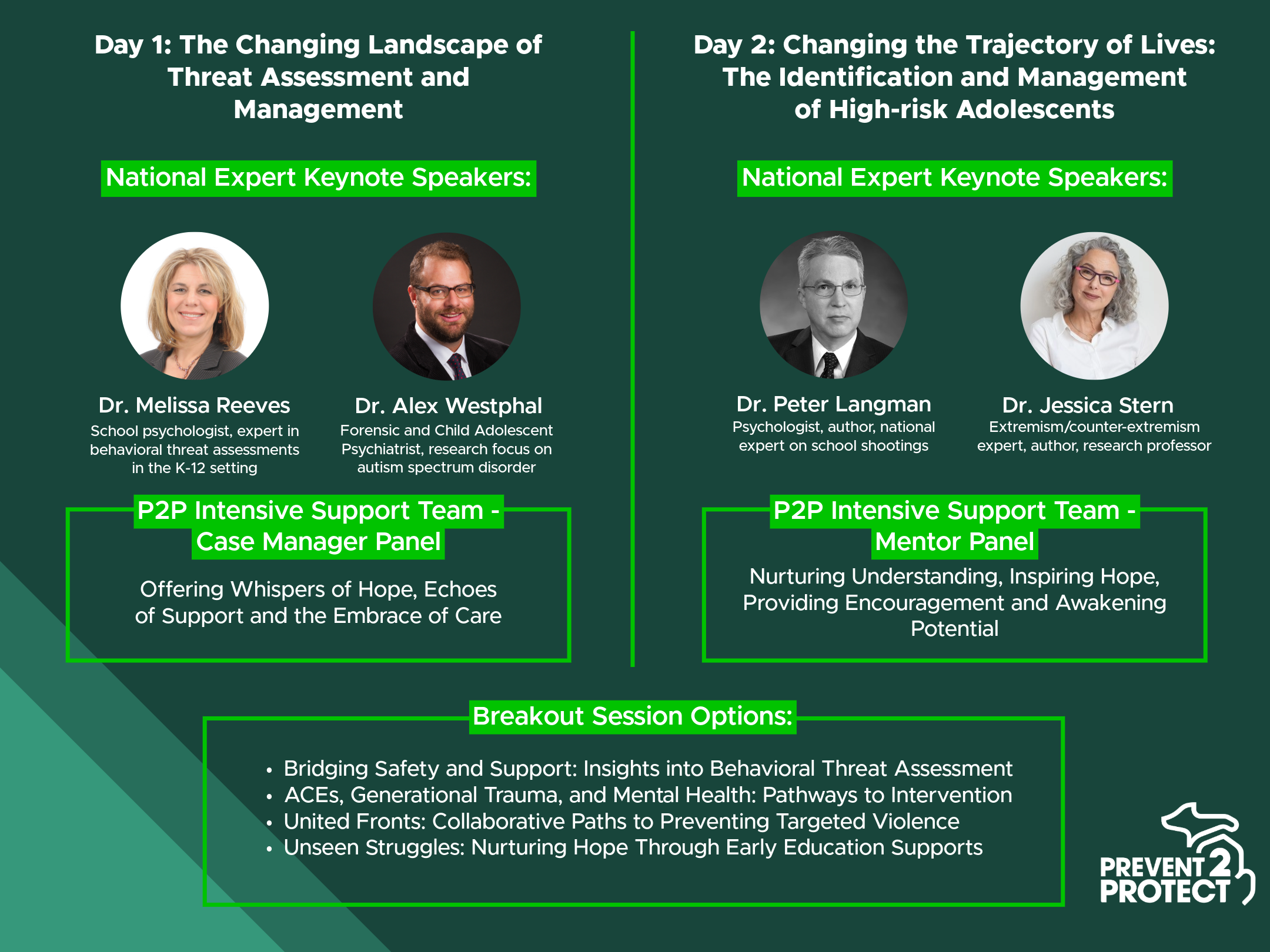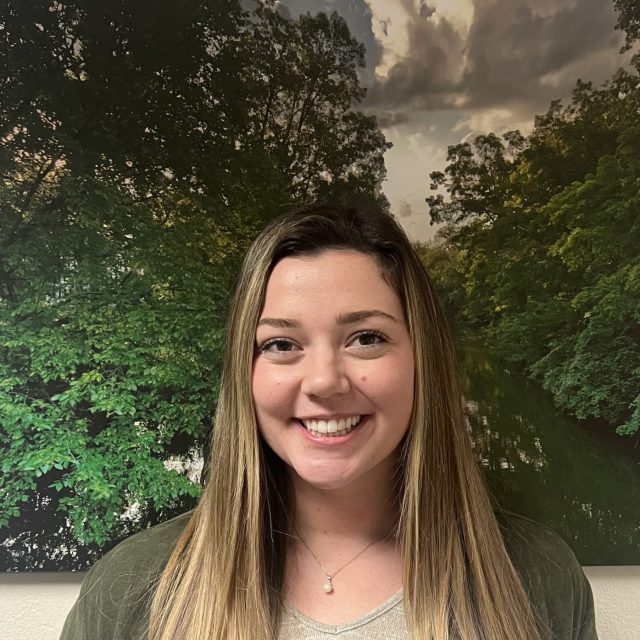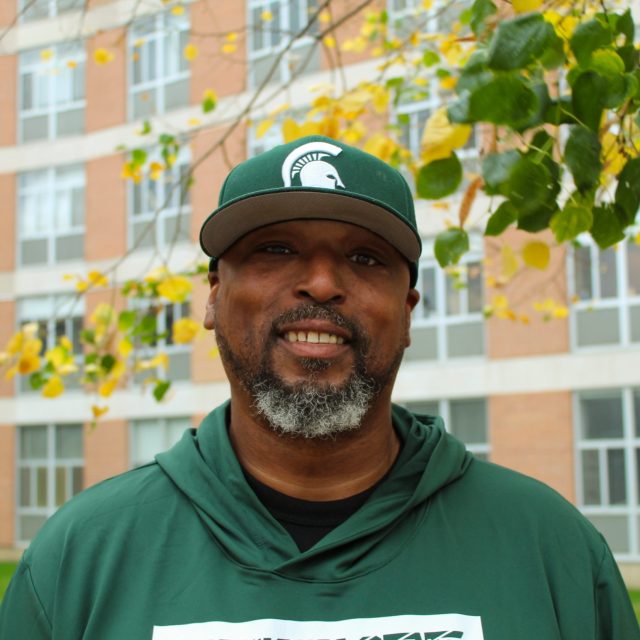Prevent 2 Protect’s 2025 Adolescent Targeted Violence Prevention Conference
September 8 - 9, 2025, 8:00 am - 5:00 pm
Join us at the Kellogg Center on the beautiful campus of Michigan State University for the 2025 Prevent 2 Protect Conference. Taking place on September 8th and 9th from 8:00 am to 5:00 pm, this conference will highlight our groundbreaking, one-of-a-kind, cross-systems intervention focused on stopping targeted school violence before it happens by supporting the management of high-risk students and keeping our children, educators, and communities safe.
Featuring leading national experts in threat assessment, mental health, and school safety, this conference offers in-depth keynote sessions, real-world case studies, and examination of our innovative multidisciplinary intervention project that is changing how schools and communities address potential threats before they escalate.
Attendees will gain insight into the implementation of our model and lessons learned from our communities already using this approach. Whether you’re an educator, mental health professional, law enforcement official, or policy leader, this conference provides critical tools and knowledge to help identify, assess, and intervene early before a crisis turns into tragedy.
Don’t miss this opportunity to learn more and be part of the solution. Together, we can Prevent 2 Protect.
Sign Up Now to Join Us!
Please use the link below to register
There is no cost to register for the conference, however, registration is limited to the first 350 guests
Discover What to Expect
Day 1: September 8
The Changing Landscape of Threat Assessment and Management
The landscape of threat assessment is shifting dramatically in Michigan and throughout the country. In January 2025, Michigan passed bipartisan legislation aimed at proactively addressing school violence. This legislation mandates every school to establish a Behavioral Threat Assessment and Management (BTAM) team by October 1, 2026. This reflects a clear shift from a reactive to a preventive approach in school safety, setting a new standard in Michigan.
Prevent 2 Protect Update

By Helping One, We Will Save Many
Alyse Folino Ley, DO
Director, Prevent 2 Protect
Dr. Folino Ley is a board certified Child and Adolescent Psychiatrist who has expertise in working with adults, children, and adolescents with trauma-related disorders, mood disorders, anxiety disorders, developmental disorders, ADHD, learning disorders, and psychotic disorders. She has subject matter expertise in preventing targeted violence and resiliency and recovery efforts following mass trauma events. She has served on Governor Whitmer’s Michigan School Safety and Mental Health Commission since 2022.
Rooted in companionship, Prevent 2 Protect helps high-risk adolescents foster a connection to the community by cultivating a sense of competence and meaningful contribution. In this session, Dr. Folino Ley, Director of Prevent 2 Protect, will discuss the journey from foundational research to the birth of a pioneering model. She will retrace its thoughtful construction, transformative implementation, and the unfolding story of its impact in Michigan.
National Expert Keynote Speakers

Threats, Teams & Tools: Demystifying Behavioral Threat Assessment in Schools
Melissa Reeves, PhD, NCSP, LPC
Dr. Melissa Reeves is a nationally certified school psychologist, licensed special education teacher, licensed professional counselor, and former district coordinator of social/emotional/behavioral services. She is a past president of the National Association of School Psychologists (2016-17), was most recently an Associate Professor at Winthrop University, and previously worked for the Cherry Creek School District in Colorado. Dr. Reeves has over 20 years’ experience working in public schools and a private school, in addition to providing mental health services in day and residential treatment settings.
As concerns about school safety grow, proactive strategies like Behavioral Threat Assessment and Management (BTAM) are essential. This session will provide a foundational overview of BTAM—what it is, why it matters, and how it supports safe and supportive school environments. The new Michigan law will be reviewed along with resources for training and strategies to strengthen collaboration and readiness. Legal liability concerns will be addressed with a balanced lens, equipping participants with facts, not fear.
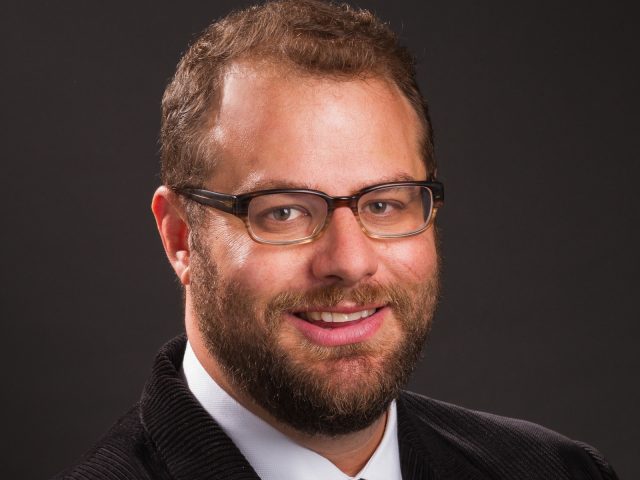
The Pathway from Neurodivergence to Danger: How Isolation Transforms Vulnerability into Violence
Alexander Westphal, MD, PhD
Dr. Westphal is an associate professor, adjunct, at Yale’s Division of Law and Psychiatry. He has a clinical and research focus on Autism Spectrum Disorder and is particularly interested in clinical risk assessment and ASD, as well as other topics related to ASD and the legal system. He is an editor of Springer’s Handbook of Autism Spectrum Disorder and the Law and prior chair of the American Academy of Psychiatry and the Law’s committee on Developmental Disabilities.
I examine the distinction between neurodivergence, including autism, as an inherent characteristic and the environmental factors that can lead to extremism and violence. Rather than suggesting that autism or other developmental conditions directly cause extremist behavior, the presentation explores how social isolation acts as the key transformative mechanism that converts potential vulnerability into actual risk. The talk traces the pathway from initial neurodivergent traits—such as social communication differences or intense interests—through experiences of chronic exclusion, bullying, and marginalization, to the development of grievances and eventual susceptibility to extremist rhetoric. By mapping this progression, the presentation demonstrates that isolation, not neurodivergence itself, is the primary driver of radicalization risk, while also identifying critical intervention points where connection, inclusion, and support can redirect potentially dangerous trajectories toward positive outcomes. The talk concludes with strategies for preventing this transformation by addressing social exclusion rather than pathologizing neurodivergent individuals.
P2P Intensive Support Team - Case Manager Panel
Offering Whispers of Hope, Echoes Of Support, and the Embrace Of Care
This heartfelt panel of individuals with expertise in education, social work, forensic interviewing, child advocacy, and school psychology will share stories of resilience, compassion, and the quiet power of support that is transforming the lives of high-risk adolescents.
Breakout Sessions
Participants will choose one breakout session each day.
P2P Education Policy Team – Danielle Murphy, Mary Gebara, Noah Petzak
This breakout session covers key insights into the new educational policy regarding Behavioral Threat Assessment and Management (BTAM), including case examples, new legislation impacting school safety, and current trends. It highlights implementation challenges, referral patterns, and best practices based on our P2P observations.

P2P Mental Health Team – Alyse Ley, Martine Highet, Megan Goldstein
This session explores the impact of adverse childhood experiences (ACEs) and untreated psychiatric conditions on child outcomes. It examines the connection between psychiatric conditions and targeted violence, emphasizing the medical urgency of suicidal and homicidal ideation (SI/HI) and barriers to treatment. The discussion includes Prevent 2 Protect (P2P) discoveries on ACEs, generational trauma, diagnoses, treatment compliance, and outcomes.

P2P Law Enforcement Team – Ellery Sosebee, Traci Austin, Jay Greene
This session presents a case example highlighting the need for community collaboration and standardized approaches among school BTAM, law enforcement, and prosecutors in addressing targeted violence threats. We review patterns of threat, weapon access, and legal outcomes from Prevent 2 Protect adolescents, with comparisons to NTAC findings. The discussion also covers identifying credible threats and best practices for timely, effective follow-up.

P2P Education Team – Syriah Dobis, Adam Royer, Robert Clark
This session reviews case examples illustrating how unmet educational needs can impact students’ self-esteem and lead to grievances against schools. It examines Prevent 2 Protect observations of the prevalence of IEPs, 504 plans, and early intervention designations, highlighting barriers like truancy and expulsion that hinder timely assessment. The session highlights the vital importance of early detection and timely intervention in special education to effectively address root challenges.
Day 2: September 9
Changing the Trajectory of Lives: The Identification and Management of High-Risk Adolescents
Transforming the path of adolescent lives begins with recognizing early warning signs and escalating behaviors that precede acts of violence. Early identification allows us to connect students with the support and resources they need, reducing risk and fostering well-being. In doing so, we build stronger, safer school communities where every student is safe and has the opportunity to thrive.
National Expert Keynote Speakers

School Shootings - Perpetrators and Prevention Lessons Learned from a Threat Assessment that Failed
Peter Langman, PhD
Dr. Peter Langman is a psychologist internationally recognized for his research on school shooters, with his work featured in multiple languages and cited in congressional testimony. His work has informed the FBI and Secret Service and has been featured worldwide. He is the author of Why Kids Kill, School Shooters, and Warning Signs. In 2025, he became Senior Advisor on Violence Prevention at ZeroEyes.
This presentation explains the variations among school shootings, including random, targeted, and mixed attacks. We will then explore three psychological types of shooters—psychopathic, psychotic, and traumatized—using case examples to illustrate the types, and highlighting patterns of failures and rejections that contribute to the shooters’ rage and motivations for violence. The second half focuses on the danger of stereotypes about school shooters, discusses common warning signs of potential violence, the concept of “evidence of imminence,” and addresses the many reasons why people often do not take warning signs seriously.
The presentation focuses on an incident in which a student threatened to kill a school employee. The administration conducted a threat assessment and concluded that the student presented a “low level” threat. Three months later, he committed his attack. What went wrong? Where did the threat assessment fall short? What more could have been done? This workshop looks at the records that have been released to highlight key aspects of the threat assessment process, impediments to the flow of information, and the facts that could have been discovered with a more thorough, ongoing investigation.

The Evolving Role of Ideology in Targeted Violence
Jessica Stern, PhD
Dr. Stern is a research professor at Boston University and a leading expert on terrorism and public safety. A 2024–2025 Guggenheim Distinguished Scholar, she has advised U.S. government agencies, taught counterterrorism for over 25 years, and served on President Clinton’s National Security Council. Her work has been supported by NSF, DHS, NATO, and NIJ as well as foundations. Stern is the author of several books on targeted violence and is currently researching a book on prevention.
School shooters increasingly exhibit qualities traditionally associated with terrorists—valorizing previous attackers, participating in fandom sites, expressing pro-Nazi sentiments, and joining online communities—thereby challenging conventional distinctions between these forms of violence. This convergence reflects a broader shift away from ideology-centric models of terrorism that have dominated the field for decades, as researchers struggle to explain contemporary phenomena that contradict the primacy of ideological commitment. The emergence of nihilistic groups whose primary ideology appears to be violence itself, combined with the prevalence of ideology hopping and “salad bar” composite ideologies, suggests that traditional frameworks focusing on coherent ideological drivers may be inadequate for understanding contemporary targeted violence. I will argue that personal factors — including psychological ones — serve as the primary drivers of targeted violence, with significant implications for prevention.
Community Conversations
Crisis Intervention Team & Community Collaboration
Join us for a powerful and timely panel discussion at the Prevent 2 Protect Conference, highlighting innovative community collaborations that bring together mental health advocates, law enforcement, and faith-based leaders to support individuals in crisis. This “Community Conversation” will explore how partnerships are transforming crisis response and improving outcomes for people living with mental illness. Our panelists will share real-world insights, successes, and challenges in building trust, improving communication, and creating systems that prioritize care and treatment. Don’t miss this opportunity to engage in a candid dialogue on how collaborative efforts can create safer, more compassionate communities.

Kevin Fischer
NAMI Michigan & Crisis Intervention Team (CIT) International Michigan Executive Director
Kevin Fischer is the Executive Director of NAMI Michigan and CIT International Michigan, leading efforts to improve community responses to mental health crises. He became an advocate after his son Dominique was diagnosed with mental illness in 2007 and died by suicide in 2010. Since joining NAMI in 2011, Kevin has served in multiple leadership roles, becoming Executive Director in 2014. He also founded The Dominique Fischer Memorial Foundation and EVERYBODY-VS-STIGMA.com, and serves on several state mental health commissions. Recognized with numerous awards, Kevin is committed to ending the stigma surrounding mental illness to improve early diagnosis, treatment, and outcomes.

Pastor Terrence King
Chief Servant Officer and Co-Founder of Kingdom Ministries
Pastor Terrence J. King is the Chief Servant Officer and Co-Founder of Kingdom Ministries, headquartered in Lansing, Michigan, and leads the Christian Celebration Center Church (KM Center Campus). A former Vice President and campus pastor at Cornerstone University, he dedicates his life to guiding others toward discovering, focusing on, and fulfilling their divine purpose. Pastor King teaches that God’s love is unconditional and that a personal, transformative relationship with Jesus is within reach for anyone willing to receive it.
Beyond the pulpit, he plays a prominent role in community leadership, most notably through the Assembly of Lansing Pastors, where he collaborates on initiatives to address pressing issues such as the intersection of faith and mental health, gun violence, racial disparities, and housing insecurity. His insights on fostering unity across cultural divides are also featured on the WCSG podcast “Beyond the Pulpit.”
P2P Intensive Support Team - Mentor Panel
Nurturing Understanding, Inspiring Hope, Providing Encouragement, and Awakening Potential
A dynamic panel exploring strategies to foster empathy, ignite hope, and provide encouragement through mentorship, empowering adolescents to unlock their full potential.
Breakout Sessions
Participants will choose one breakout session each day. P2P Education Policy Team – Danielle Murphy, Mary Gebara, Noah Petzak
P2P Education Policy Team – Danielle Murphy, Mary Gebara, Noah Petzak
This breakout session covers key insights into the new educational policy regarding Behavioral Threat Assessment and Management (BTAM), including case examples, new legislation impacting school safety, and current trends. It highlights implementation challenges, referral patterns, and best practices based on our P2P observations.

P2P Mental Health Team – Alyse Ley, Martine Highet, Megan Goldstein
This session explores the impact of adverse childhood experiences (ACEs) and untreated psychiatric conditions on child outcomes. It examines the connection between psychiatric conditions and targeted violence, emphasizing the medical urgency of suicidal and homicidal ideation (SI/HI) and barriers to treatment. The discussion includes Prevent 2 Protect (P2P) discoveries on ACEs, generational trauma, diagnoses, treatment compliance, and outcomes.

P2P Law Enforcement Team – Ellery Sosebee, Traci Austin, Jay Greene
This session presents a case example highlighting the need for community collaboration and standardized approaches among school BTAM, law enforcement, and prosecutors in addressing targeted violence threats. We review patterns of threat, weapon access, and legal outcomes from Prevent 2 Protect adolescents, with comparisons to NTAC findings. The discussion also covers identifying credible threats and best practices for timely, effective follow-up.

P2P Education Team – Syriah Dobis, Adam Royer, Robert Clark
This session reviews case examples illustrating how unmet educational needs can impact students’ self-esteem and lead to grievances against schools. It examines Prevent 2 Protect observations of the prevalence of IEPs, 504 plans, and early intervention designations, highlighting barriers like truancy and expulsion that hinder timely assessment. The session highlights the vital importance of early detection and timely intervention in special education to effectively address root challenges.
Conference Venue & Nearby Accommodations
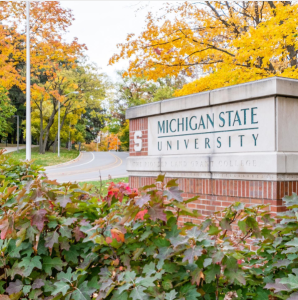 Nestled in the heart of Michigan State University’s scenic campus, the Kellogg Hotel & Conference Center, located at 219 S. Harrison Road, East Lansing, MI 48824 provides guests with modern amenities, on-site dining, and bustling campus life just steps from your room and our sessions. Whether you’re traveling from across town or across the country, you’ll find everything you need for a comfortable, inspiring stay. (For other area accommodations, please see drop down below).
Nestled in the heart of Michigan State University’s scenic campus, the Kellogg Hotel & Conference Center, located at 219 S. Harrison Road, East Lansing, MI 48824 provides guests with modern amenities, on-site dining, and bustling campus life just steps from your room and our sessions. Whether you’re traveling from across town or across the country, you’ll find everything you need for a comfortable, inspiring stay. (For other area accommodations, please see drop down below).
A special room block has been reserved for Prevent 2 Protect Conference attendees. Please see the drop down below.
Parking is available in Ramp 4/Lot 66. Parking charges are $2.00 per hour and are payable using the Spot On App (additional fees may apply) or on-site Kiosk. Overnight guest parking is available in Ramp 4/Lot 66 at the rate of $15 per car/per day.
The Kellogg Center is easily accessible:
- From I-496: Take Exit 7 for Trowbridge Road toward Michigan State University, then turn left on Harrison Road.
- From US-127: Take the Trowbridge Road exit east toward campus, then turn left onto Harrison Road.
- From I-96: Merge onto I-496 East toward Lansing, then follow the directions above.
Parking is available in Ramp 4/Lot 66. Parking charges are $2.00 per hour and are payable using the Spot On App (additional fees may apply) or on-site Kiosk. Overnight guest parking is available in Ramp 4/Lot 66 at the rate of $15 per car/per day.
Guest rooms are available for the nights of September 7-8, 2025.
Kellogg Hotel and Conference Center (219 S. Harrison Rd., East Lansing, MI 48824)
RATE: $129 plus tax
RESERVE: Guests call (800) 875-5090 and use room block code 2509Preven to identify themselves as part of the Prevent 2 Protect 2025 Adolescent Targeted Violence Prevention Conference.
DEADLINE: Reserve by August 8, 2025, to receive this special rate.
Parking is available in Ramp 4/Lot 66. Parking charges are $2.00 per hour and are payable using the Spot On App (additional fees may apply) or on-site Kiosk. Overnight guest parking is available in Ramp 4/Lot 66 at the rate of $15 per car/per day.
Graduate by Hilton East Lansing (133 Evergreen Ave., East Lansing, MI 48823; approx. 0.5 mile away)
Hyatt House Lansing University Area (3150 E. Michigan Ave., Lansing, MI 48912; approx. 1.0 mile away)
AC Hotel Lansing University Area (3160 E. Michigan Ave., Lansing, MI 48912; approx. 1.0 mile away)
Marriott East Lansing at University Place (300 Mac Ave., East Lansing, MI 48823; approx. 0.7 mile away)
Towneplace Suites East Lansing (2841 Hannah Blvd., East Lansing, MI 48823; approx. 2.1 miles away)
Candlewood Suites East Lansing by IHG (3545 Forest Rd., East Lansing, MI 48910; approx. 2.5 miles away)
Springhill Suites by Marriott University Area (1100 Trowbridge Rd., East Lansing, MI 48823; approx. 1.0 mile away)
Email Prevent 2 Protect at prevent2protect@msu.edu or call (517) 329-4250 with any further questions about the conference.
Conference Program
Prevent 2 Protect and the 2025 Adolescent Targeted Violence Prevention Conference are made possible by funding provided to Michigan State University by the Michigan Department of Education.

